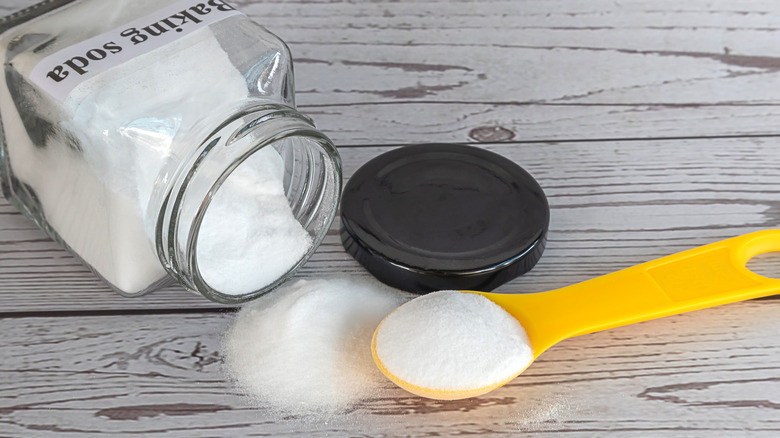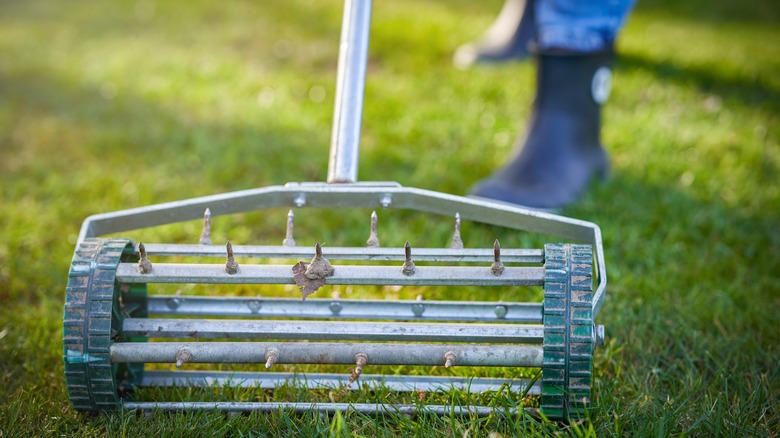Use A Common Kitchen Ingredient To Get Rid Of Liverwort Weeds In The Lawn
Sometimes considered a problem weed, liverwort (Marchantia) is a moss-like plant that thrives in moist environments and is one of the oldest plants in the world. There are around 9,000 liverwort species, but the Marchantia is commonly on lawns, especially in areas with inadequate drainage and partial or full shade. The Royal Horticulture Society (RHS) states that while liverwort won't directly kill your plants, its presence can block light and can make the surface slippery as it forms dense mats. If you have ornamental lawn plants, it may compete with the plants fighting for available food, space, and light. Yet you don't need to resort to traditional herbicide to get rid of liverwort. The secret to ridding your lawn of it is a common household item: baking soda, or sodium bicarbonate.
Once present, liverwort can spread quickly thanks to its reproductive abilities. New growth occurs both asexually by budding, and sexually with male and female organs. When you add in an enticing environment for the liverwort rich with nitrogen and moisture, you can quickly have a growing problem with it on your lawn. Getting rid of liverwort with baking soda is an easy all-natural approach towards removing this irritating weed without powerful herbicides. You just need to follow a few careful steps.
Using baking soda to kill liverwort
You can get rid of pesky weeds like liverwort with baking soda easily by dusting the liverwort with it. It's best to apply in dry conditions and not directly before or after a rainstorm to avoid dilution. The alkaline properties of baking soda help kill liverwort by depriving it of its much-loved moisture and raising its pH. Based on various research by horticultural experts, the best approach is to apply 2-4 gallons per square foot to control the risk of killing other plants. After application, the liverwort will eventually turn black, a sign it's dying off due to lack of moisture and the increased pH.
Some gardening experts prefer to apply a baking soda solution to liverwort and other weeds instead. You can make your own by combining 1 cup of baking soda with 1 gallon of water, then spraying as needed. Keep in mind, results on this approach are mixed, and it can be hard to not spray adjacent plants, so you run the risk of inadvertently killing them as well.
Minimize liverwort growing in your lawn
To stave off future liverwort invasions on your lawn, focus on creating unfavorable conditions for the weed. First, remove any existing liverwort with a spade. As its growth depends heavily on moisture and soil health, you will need to make adjustments to your soil or the liverwort will simply return. You can do this by improving drainage in water heavy areas, plus changing your lawn irrigation approach can also help. Aerate your lawn to make the grass healthier and treat any waterlogged spots or areas with high compaction without any other plant growth, as these spots are where liverwort can flourish, potentially ruining your landscape.
When mulching your lawn, choose a coarse, dense mulch option such as cocoa hull or other organic mulch options. Finally, if you use fertilizer, don't overfertilize and avoid using any quick-release fertilizer to quickly deliver nutrients to soil. Liverwort loves nitrogen-rich conditions, preferring levels between 75 and 250 ppm, so be mindful of these conditions, noticing if your soil lacks nitrogen.


